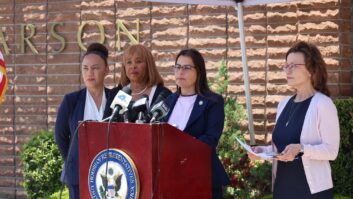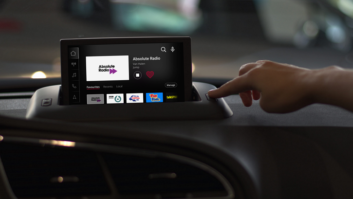This is one in a series of profiles of companies involved in emergency alerting.
RINGGOLD, Ga. Broadcast technology company DataFM believes the Federal Emergency Management Agency should give serious consideration to using the Radio Broadcast Data System, and specifically the company’s patented software, when the government agency releases specs for a new digital emergency alert system.
DataFM says RBDS, a communications protocol standard for embedding small amounts of digital information in the subcarrier of terrestrial FM radio broadcasts, is an underused technology that is well-suited for public warning uses.
The DataFM system is a multi-use, point-to-multi-point communication system that is both geographic and demographic specific, according the company’s Web site. The system is being used for emergency messaging in every hospital in the state of Georgia, according to the site.
Other firms have pushed FEMA to use RBDS technology as part of a new EAS, most notably Global Security Systems and its Alert FM product. DataFM officials contend their product is better than others available because it can specifically target geographic areas and demographic groups.
(click thumbnail)
DataFM offers visitors to its Web site a chart comparing the benefits of its alerting approach to other systems such as reverse 911, cell phones and e-mail. “Our patented technology is individually addressable. That is what makes us unique. We can message a very specific group of people. Essentially, it is a point-to-point system,” said Marshall Bandy, president of DataFM.
Global Security Systems disputes DataFM’s claims that it alone can send targeted and addressable information. “We do a similar type of geo-targeting,” said Matthew Straeb, executive vice president for GSS.
The DataFM patent, which was issued by the United States Patent and Trademark Office and titled the “Codeable Programmable Receiver,” speaks for itself, Bandy said.
However, using any kind of patented technology worries some EAS observers, who would prefer that FEMA choose an “open, non-proprietary” set of systems for EAS.
A proprietary system like DataFM’s “is 180 degrees out of phase with the parameters of what the Partnership for Public Warning set down as a premise for warning systems,” said one EAS observer.
The Partnership for Public Warning was a non-profit consortium of government and private industry groups that looked for ways to improve public warning from 2001 until it was disbanded in 2005.
FM subcarrier system
Bandy said his company’s primary role in Georgia is notification in the event of a pandemic on behalf of the Georgia Division of Public Health. The company also is part of the Atlanta Metropolitan Medical Response System, which includes 22 counties around metropolitan Atlanta.
“We also have the system installed in all of the Atlanta public schools,” Bandy said.
The company uses the subcarrier of approximately 34 FM radio stations in the state, Bandy said, to send text and other data via RBDS. That includes 13 Georgia Public Broadcasting stations.
Radio stations — some of which are paid what the company describes as a modest fee — are equipped with a satellite receiver and RBDS equipment, which allows the stations to scroll song title and artist information to car radios capable of receiving RBDS data, Bandy said. However, only a DataFM receiver, which the company sells for $200, is capable of receiving warnings.
More than 550 individually addressable RBDS receivers are deployed in Georgia, Bandy said, most of them in schools, hospitals and emergency centers.
DataFM, founded by Bandy in 1997, has met with the FCC’s engineering staff and pitched the RBDS platform and its digital EAS capabilities, Bandy said. The company has been active in filing reply comments to several FCC Notice of Proposed Rulemakings concerning public warning.
“We believe it is important to utilize the FM band. The existing ubiquitous infrastructure is there. It’s already built. This is the highest and best use of the technology.
“It’s important for radio broadcasters to embrace the opportunity. This is a chance to be in the communications business but outside of the realm of entertainment only. It’s communication with the ability to deliver information by addressing it to geographic and demographic specific groups. This is the largest area of the wireless arena yet to be tapped,” Bandy said.
In addition to future in-car delivery of alerts via RBDS, DataFM theorizes that someday an FM radio data chip could be implanted in all newly marketed cell phones and similar electronic devices, which would be capable of receiving text alerts.
‘Too many links’
One supporter of DataFM’s efforts believes the company is on the cutting edge of a technology that could really improve public warning in this country.
“This is very forward-thinking technology, opposite of what EAS has been to this point. Both EAS and the old EBS suffer from the same cancer; too many links in the daisy chain,” said Stephen Rutherford, market director of engineering for the Beasley Broadcasting cluster in Las Vegas.
“The (DataFM) system allows you to send a message to a specific receiver or receivers. Others can flood the area with pages, but DataFM is a targeted system.”
Rutherford had experience with DataFM when he worked for Archway Broadcasting Group in Columbus, Ga., and installed a DataFM RBDS system in one of the group’s FM radio stations. He later did some equipment installation work for DataFM, though he said he is not lobbying FEMA on behalf of the company.
“The DataFM system is heads and shoulders above anything the current or enhanced EAS is capable of achieving,” Rutherford said.
Bandy, a former radio station owner who has been involved in RBDS since the mid-1990s, said, “RBDS gives FM radio stations an opportunity for additional revenue at a time when they need it most. In addition, there is the community service aspect of airing public warnings.”
Some veteran EAS watchers have expressed concern over companies using FM subcarriers to disseminate public warnings.
“How much are they willing to pay for the use of a station’s RBDS capabilities?” asked one such observer.
Bandy declined to release any information in regards to what the company pays an FM radio station for the use of a subcarrier.
FEMA has been criticized by some in the EAS community for not acting quickly enough on EAS. FEMA has been working on its Integrated Public Alert and Warning System since 2004 and an executive order in 2006 ordered them to finish it.
A Government Accountability Office report in September faulted the Department of Homeland Security for FEMA’s lack of progress on EAS. Among other things, it found that FEMA kept poor records of how much money it had spent on implementing an improved EAS. The GAO report on EAS also said FEMA has failed to integrate alternative media, such as cell phones, BlackBerrys and the Internet, into EAS.
FEMA has said it hopes to adopt the Common Alert Protocol (CAP) Version 1.2 in early 2010. DataFM officials say their system is CAP compliant.
FEMA announced in early December 2009 that it had adopted specifications for the gateway interface for the Commercial Mobile Alert System, which will allow emergency managers to send geographically targeted text messages via cell phones beginning in 2012. Alerting companies, including DataFM and GSS, are pushing for the inclusion of a FM radio data chip in cell phones, capable of receiving RBDS text messages.
A FEMA official told Radio World earlier that the agency would study RBDS for alert and warning integration into IPAWS (Radio World, July 1, 2009).
FEMA officials declined to comment for this story.








